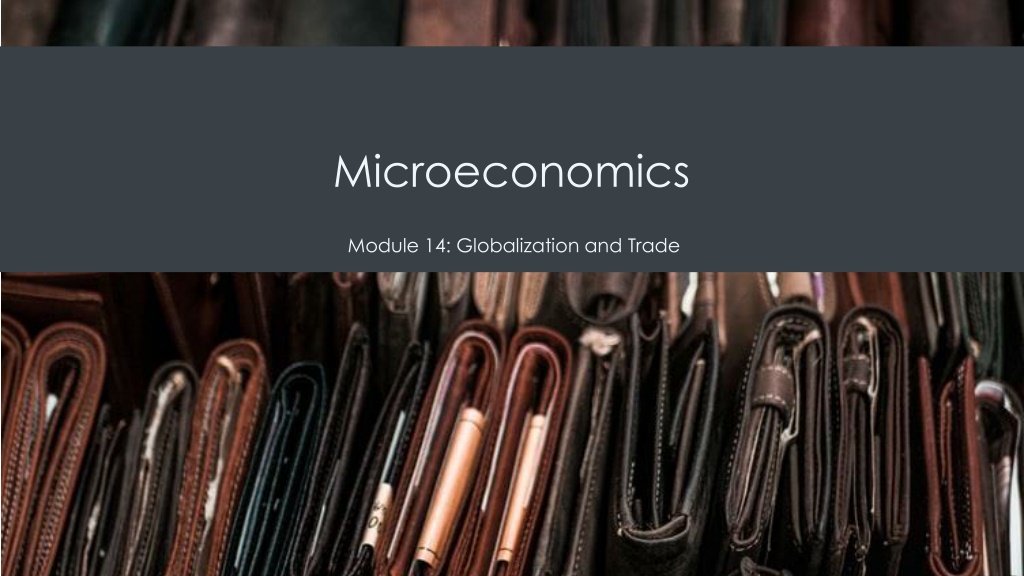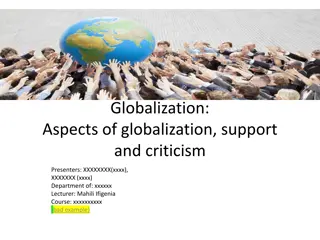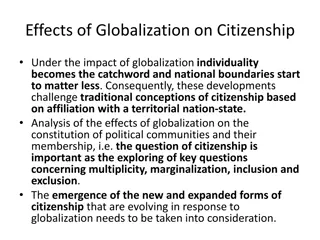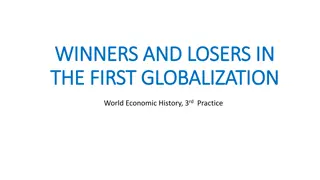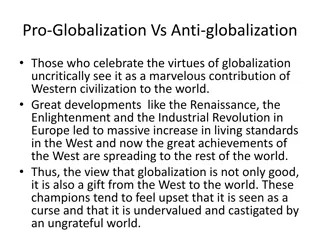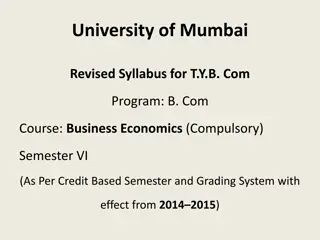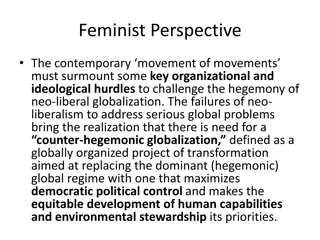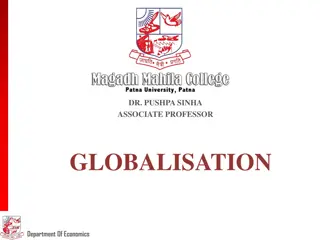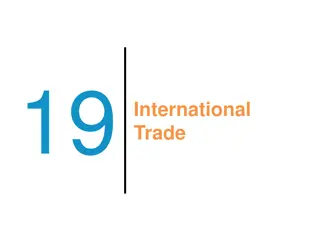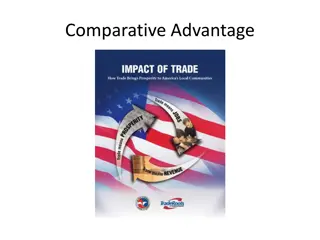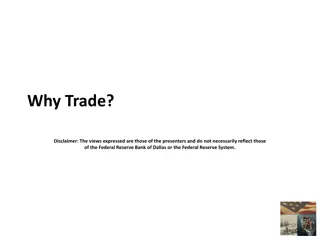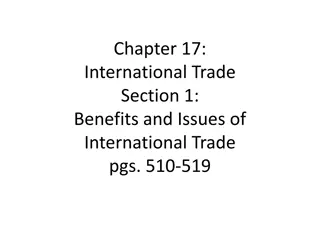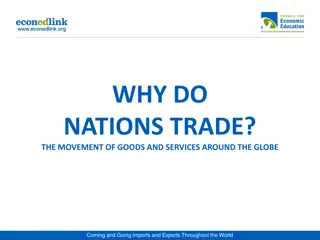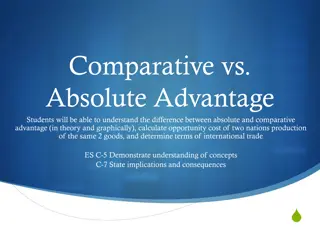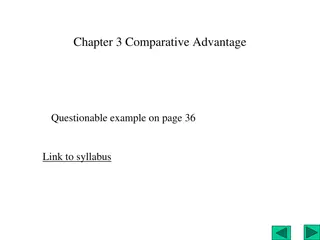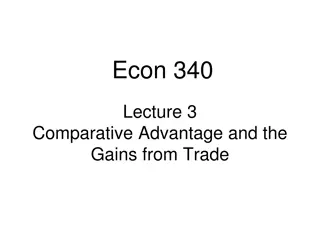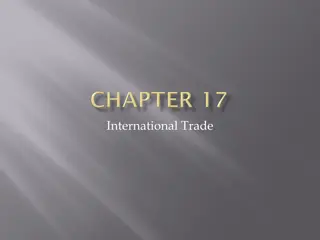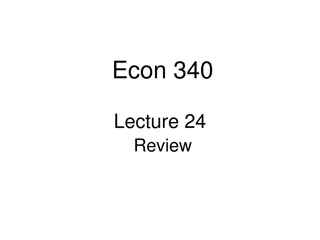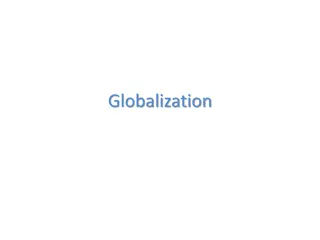Understanding Globalization, Trade, and Comparative Advantage in Economics
Globalization and trade play a crucial role in the interconnected world economy. This module explores the gains from international trade, barriers to trade, costs of globalization, and the concepts of absolute and comparative advantage. Absolute advantage is when a country can produce a good using fewer resources, while comparative advantage is based on lower opportunity costs. Even when a country has an absolute advantage in all goods, there are still gains from trade by specializing in comparative advantages.
Download Presentation

Please find below an Image/Link to download the presentation.
The content on the website is provided AS IS for your information and personal use only. It may not be sold, licensed, or shared on other websites without obtaining consent from the author. Download presentation by click this link. If you encounter any issues during the download, it is possible that the publisher has removed the file from their server.
E N D
Presentation Transcript
Microeconomics Module 14: Globalization and Trade
Why It Matters: Globalization and Trade Globalization is the process by which the world, previously isolated through physical and technological distance, becomes increasingly interconnected. What are the gains from international trade? In what sense do barriers to trade protect American workers and companies? What are the costs of globalization? Are the costs worth it?
Absolute Advantage The evidence that international trade confers overall benefits on economies is pretty strong A country has an absolute advantage over another country if it can produce a given product using fewer resources than the other country needs to use If Canada can produce 100 lbs. of beef using two ranchers, but it takes Argentina three ranchers, Canada has absolute advantage over Argentina Absolute advantage can be the result of a country s natural endowment Saudi Arabia and oil
Comparative Advantage Comparative Advantage: when a country can produce a good at a lower cost in terms of other goods; or, when a country has a lower opportunity cost of production The question each country or company should ask with trade should be: What do we give up to produce this good? If Zambia produces copper, the resources it uses cannot be used to produce other goods such as corn As a result, Zambia gives up the opportunity to produce corn Suppose it takes 10 hours of labor to mine a ton of copper in Zambia, and 20 hours of labor to harvest a bushel of corn This means the opportunity cost of producing a ton of copper is 2 bushels of corn
Absolute or Comparative Advantage If Ryen can make more tacos in an hour than Suzanne, but Suzanne can make more tacos at a lower opportunity cost, then Suzanne has a(n) ________. a. comparative advantage in making tacos b. both an absolute and comparative advantage in making tacos. c. absolute advantage in making tacos
What Happens When a Country Has an Absolute Advantage in All Goods It s typical that for high-income countries they have well-educated workers, technologically advanced equipment, etc. These high-income countries can produce all products with fewer resources than a low-income country If the high-income country is more productive across the board, will there still be gains from trade? Trade is about a mutually beneficial exchange Even when one country has an absolute advantage in all products, trade can still benefit both sides This is because gains from trade come from specializing in one s comparative advantage
Production Possibilities and Comparative Advantage Table 1. Resources Needed to Produce Shoes and Refrigerators Number of Workers needed to produce 1,000 units Shoes Number of Workers needed to produce 1,000 units Refrigerators Country United States 4 workers 1 worker Mexico 5 workers 4 workers Absolute advantage simply compares the productivity of a worker between countries Comparative advantage identifies the good for which the producer s absolute advantage is relatively larger, or where the producer s absolute productivity disadvantage is relatively smaller
Mutually Beneficial Trade with Comparative Advantage When nations increase production in their area of comparative advantage and trade with each other, both countries can benefit The production possibilities frontier is a useful tool to visualize this benefit The production possibilities frontier shows the maximum amount that each country can produce given its limited resources
Calculating Absolute and Comparative Advantage Step 1: Make a Table, similar to the one shown Step 2: To calculate absolute advantage, look at the larger of the numbers for each product Step 3: To calculate comparative advantage, find the opportunity cost of producing one barrel of oil in both countries Step 4: Calculate the opportunity cost of one lumber by reversing the numbers, with lumber on the left side of the equation Step 5: In this example, absolute advantage is the same as comparative advantage Step 6: Canada should specialize in what it has a relative lower opportunity cost, which is lumber, and Venezuela should specialize in oil Table 6. Oil and Lumber Production in Canada and Venezuela Lumber (tons) Country Oil (barrels) Canada 20 or 40 Venezuela 60 or 30
Trade and Incomes Incomes depend on labor productivity A country with an absolute advantage in some product has higher labor productivity The average income in a country depends on its average labor productivity Comparative advantage is more important than absolute advantage in understanding which country should trade which product in order to maximize the standard of living in both countries
The Prevalence of Intra-Industry Trade between Similar Economies The theory of comparative advantage suggests that each economy should specialize to a degree in certain products, and then exchange those products A high proportion of trade is intra-industry trade, trade of goods within the same industry from one country to another The benefits of having workers with similar skills work in other parts of the world are: The division of labor leads to learning, innovation, and unique skills Economies of scale
Gains from Specialization and Learning Specialization in the world economy can be very finely split In fact, recent years have seen a trend in international trade called splitting up the value chain The value chain describes how a good is produced in stages Instead of production in a single large factory, all of the steps of production can be split up among different firms operating in different places and even different countries Because firms split up the value chain, international trade often does not involve whole finished products Intra-industry trade between similar countries produces economic gains because it allows workers and firms to learn and innovate on particular products
Economies of Scale, Competition, Variety A second broad reason that intra- industry trade between similar nations produces economic gains involves economies of scale The concept of economies of scale means that as the scale of output goes up, average costs of production decline The horizontal axis of the figure shows the quantity of production by a certain firm or at a certain manufacturing plant
Economies of Scale Advantages The concept of economies of scale becomes especially relevant to international trade when it enables one or two large producers to supply the entire country International trade provides a way to combine the lower average production costs that come from economies of scale and still have competition and variety for consumers Large automobile factories in different countries can make and sell their products around the world If the U.S. automobile market was made up of only General Motors, Ford, and Chrysler, the level of competition and consumer choice would be quite a lot lower Greater competition brings with it innovation and responsiveness to what consumers want
Dynamic Comparative Advantage The sources of gains from intra-industry trade between similar economies In intra-industry trade, the level of worker productivity is not determined by climate or geography It is not even determined by the general level of education or skill Instead, the level of worker productivity is determined by how firms engage in specific learning about specialized products In this vision, comparative advantage can be dynamic, it can evolve and change over time as new skills are developed and as the value chain is split up in new ways
Demand and Supply Analysis of International Trade We can use the theory of supply and demand to further understand the benefits of international trade Consider two countries, Brazil and the United States, who produce sugar If international trade between Brazil and the U.S. becomes possible, firms will want to buy cheap in Brazil and sell at a high price in the U.S.
Protectionism Globalization has brought fear of loss of jobs and loss of income, which are often described as the race to the bottom Globalization has also spawned fears about loss of culture Many countries worry about their cultures being overwhelmed by that of the United States When a government legislates policies to reduce or block international trade it is engaging in protectionism Protectionist policies often seek to shield domestic producers and domestic workers from foreign competition The Trump Administration s tariffs on steel and aluminum in 2018 are a recent example
Barriers to Trade Protectionism takes three main forms: Tariffs are taxes that a government imposes on imported goods and services Makes imports more expensive, discourages purchases Import quotas are numerical limitations on the quantity of products that a country can import During the early 1980s, the Reagan Administration imposed a quota on the import of Japanese automobiles Nontariff barriers are all the other ways that a nation can draw up rules, regulations, inspections, and paperwork to make it more costly or difficult to import products Textiles made in the U.S. are shipped to another country, combined with textiles from another country and then shipped back to the U.S. for final assembly
The Tradeoffs of International Trade The common belief among economists is that it is better to embrace the gains from trade, and then deal with the costs and tradeoffs with other policy tools, instead of no trade at all Most people who live in market-oriented economies would oppose trying to block better products that lower the cost of services The economic analysis of free trade does not rely on a belief that foreign trade is not disruptive or does not pose tradeoffs Disruptive market change happens when a innovative new product or production technology disrupts the status quo in a market The potential for gains from trade may be especially high among the smaller and lower-income countries of the world
From Interpersonal to International Trade We all benefit from living in economies where people and firms can specialize and trade with each other The benefits of trade do not stop at national boundaries The division of labor could increase output for three reasons: 1. Workers with different characteristics can specialize in the types of production where they have a comparative advantage 2. Firms and workers who specialize in a certain product become more productive with learning and practice 3. Economies of scale These three reasons apply from the individual and community level right up to the international level
Reducing Barriers to Trade At the end of World War II, there was a consensus that tariffs were too high worldwide Tariff reductions could stimulate international trade and return the world to a thriving, peacetime economy The General Agreement on Tariffs and Trade (GATT), was established in 1947 by the U.N. to provide a forum in which nations could come together to negotiate reductions in tariffs and other barriers to trade In 1995, the GATT was transformed into the World Trade Organization (WTO) The GATT process was to negotiate an agreement to reduce barriers to trade, sign that agreement, pause for a while, and then start negotiating the next agreement
The Negotiating Rounds of GATT and the World Trade Organization Table 1. The Negotiating Rounds of GATT and the World Trade Organization Number of Countries Involved 23 13 38 26 26 Year Place or Name of Round Main Subjects 1947 1949 1951 1956 1960 61 1964 67 Geneva Annecy Torquay Geneva Dillon round Tariff reduction Tariff reduction Tariff reduction Tariff reduction Tariff reduction Kennedy round Tariffs, anti-dumping measures 62 1973 79 Tokyo round Tariffs, nontariff barriers Tariffs, nontariff barriers, services, intellectual property, dispute settlement, textiles, agriculture, creation of WTO Agriculture, services, intellectual property, competition, investment, environment, dispute settlement 102 1986 94 Uruguay round 123 2001 Doha round 147
The World Trade Organization The WTO is committed to lowering barriers to trade The world s nations meet through the WTO to negotiate how they can reduce barriers to trade, such as tariffs WTO negotiations happen in rounds, where all countries negotiate one agreement to encourage trade, take a year or two off, and then start negotiating a new agreement Like the GATT before it, the WTO is not a world government, with power to impose its decisions on others The total staff of the WTO in 2013 is 629 people and its annual budget (as of 2012) is $196 million Compared to large universities, the budget is smaller in size
Regional Trading Agreements Three types of economic integration across the globe: Free trade agreements are when participants allow each other s imports without tariffs or quotas Common markets is when participants have a common external trade policy Economic unions, in addition to a common market, monetary and fiscal policies are coordinated The best known of these regional trading agreements is the European Union For the United States, perhaps the best-known regional trading agreement is the North American Free Trade Agreement (NAFTA)
Long-Term in Barriers to Trade Through all the controversy with trade policy, the general trend for most of the last 60 years is clearly toward lower barriers to trade Although measures of import quotas and nontariff barriers are less exact than those for tariffs, they generally appear to be at lower levels, too The last half-century has seen both a dramatic reduction in government- created barriers to trade, like tariffs, import quotas, and nontariff barriers A number of technological developments that have made international trade easier advances in transportation, communication, and information management The result has been the powerful surge of international trade
Quick Review What is absolute advantage and comparative advantage? How do you calculate absolute and comparative advantage? What are two advantages of intra-industry trading? What is the relationship between economies of scale and intra-industry trade? How can you use supply and demand to explain the gains from trade? Why do governments justify protectionist policies? What are trade barriers, including quotas, tariffs, and nontariff barriers?
More Quick Review What are the tradeoffs of trade policy, and what are two benefits from reducing trade barriers? What is the origin and role of the General Agreement on Tariffs and Trade (GATT)? What is the origin and role of the World Trade Organization (WTO)? What is the significance and examples of regional trading agreements? Analyze trade policy and evaluate long-term trends in barriers to trade
